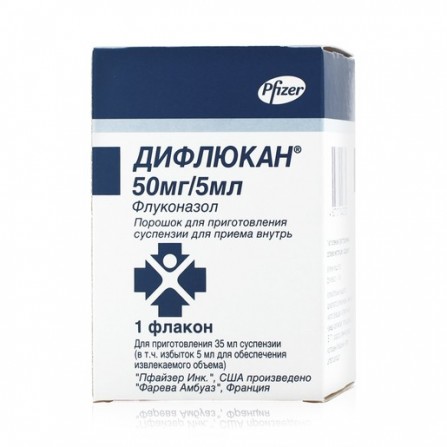Diflucan powder for suspension preparation oral 50mg 5ml 35ml
Condition: New product
1000 Items
Rating:
Be the first to write a review!

More info
Active ingredients
Fluconazole
Composition
In 5 ml of the finished suspension contain: fluconazole 50 mg. Excipients: sucrose, colloidal silicon, titanium dioxide, xanthan gum, sodium citrate, citric acid, sodium benzoate, natural orange additive.
Pharmacological effect
Fluconazole, a triazole antifungal agent. It is a potent selective inhibitor of sterol synthesis in the cell of fungi. When ingested and / or injected, fluconazole was active on various models of fungal infections in animals. The activity of the drug was demonstrated in opportunistic mycoses, incl. caused by Candida spp., including generalized candidiasis in immunocompromised animals. Cryptococcus neoformans, including intracranial infections. Microsporum spp. and Trychoptyton spp. Fluconazole activity has also been established in models of endemic mycoses in animals, including infections caused by Blastomyces dermatitides, Coccidioides immitis, including intracranial infections, and Histoplasma capsulatum in animals with normal and suppressed immunity. There have been reports of cases of superinfection caused by Candida strains other than Candida albicans, which often have natural resistance to fluconazole (for example, Candida krusei). In such cases, alternative antifungal therapy may be required. Fluconazole has a high specificity for fungal enzymes dependent on cytochrome P450. Fluconazole therapy at a dose of 50 mg / day for up to 28 days does not affect the plasma testosterone concentration in men or the concentration of steroids in women of childbearing age. Fluconazole at a dose of 200-400 mg / day does not have a clinically significant effect on the levels of endogenous steroids and their response to the stimulation of ACTH in healthy male volunteers. A single or multiple intake of fluconazole at a dose of 50 mg does not affect the metabolism of antipyrine when they are taken simultaneously.
Indications
Cryptococcosis, including cryptococcal meningitis and infections of other localization (for example, lungs, skin), including in patients with normal immune response and AIDS patients, recipients of transplanted organs and patients with other forms of immunodeficiency. supportive therapy to prevent the recurrence of cryptococcosis in AIDS patients. Generalized candidiasis, including candidemia, disseminated candidiasis and other forms of invasive candidal infection, such as infections of the peritoneum, endocardium, eyes, respiratory and urinary tract, includingin patients with malignant tumors who are in intensive care units and receive cytotoxic or immunosuppressive agents, as well as in patients with other factors predisposing to the development of candidiasis. Candidiasis of the mucous membranes, including mucous membranes of the mouth and pharynx, esophagus, non-invasive bronchopulmonary infections, candiduria, mucocutaneous and chronic atrophic candidiasis of the oral cavity (associated with the wearing of dentures), including in patients with normal and suppressed immune function. prevention of recurrence of oropharyngeal candidiasis in AIDS patients. Genital candidiasis. acute or recurrent vaginal candidiasis. prevention in order to reduce the frequency of recurrences of vaginal candidiasis (3 or more episodes per year). candidal balanitis. Prevention of fungal infections in patients with malignant tumors predisposed to such infections as a result of cytotoxic chemotherapy or radiation therapy. Mycoses of the skin, including mycoses of the feet, body, inguinal region, pityriasis versicolor, onychomycosis, and skin candidal infections. Deep endemic mycoses in patients with normal immunity, coccidioidomycosis, paracoccidioidomycosis, sporotrichosis and histoplasmosis.
Contraindications
hypersensitivity to fluconazole, other components of the drug or azole substances with a structure similar to fluconazole. simultaneous use of terfenadine during repeated use of fluconazole at a dose of 400 mg / day or more. simultaneous use of cisapride.
Use during pregnancy and lactation
The use of fluconazole during pregnancy should be avoided, except in cases of severe and potentially life-threatening fungal infections, when the expected benefit of treatment outweighs the possible risk to the fetus. Fluconazole is found in breast milk in the same concentrations as in blood, therefore it is not recommended to use Diflucan during lactation (breastfeeding).
Side effects
From the central and peripheral nervous system: headache, dizziness, convulsions, change in taste. On the part of the digestive tract: abdominal pain, diarrhea, flatulence, nausea, dyspepsia, vomiting.On the part of the liver: hepatotoxicity, including rare cases with a fatal outcome, increased levels of alkaline phosphatase, bilirubin, serum levels of ALT and AST, abnormal liver function, hepatitis, hepatocellular necrosis, jaundice. On the part of the skin and subcutaneous tissues: rash, alopecia, exfoliative skin diseases, including Stevens-Johnson syndrome and toxic necrolysis of the epidermis. On the part of the hematopoietic system and the lymphatic system: leukopenia, including neutropenia and agranulocytosis, thrombocytopenia. On the part of the immune system: anaphylaxis (including angioedema, swelling of the face, urticaria, pruritus). From the side of the cardiovascular system: an increase in the QT interval on the ECG, flicker / flutter of the ventricles. Metabolic / trophic disorders: increased plasma cholesterol and triglycerides, hypokalemia.
special instructions
From the central and peripheral nervous system: headache, dizziness, convulsions, change in taste. On the part of the digestive tract: abdominal pain, diarrhea, flatulence, nausea, dyspepsia, vomiting. On the part of the liver: hepatotoxicity, including rare cases with a fatal outcome, increased levels of alkaline phosphatase, bilirubin, serum levels of ALT and AST, abnormal liver function, hepatitis, hepatocellular necrosis, jaundice. On the part of the skin and subcutaneous tissues: rash, alopecia, exfoliative skin diseases, including Stevens-Johnson syndrome and toxic necrolysis of the epidermis. On the part of the hematopoietic system and the lymphatic system: leukopenia, including neutropenia and agranulocytosis, thrombocytopenia. On the part of the immune system: anaphylaxis (including angioedema, swelling of the face, urticaria, pruritus). From the side of the cardiovascular system: an increase in the QT interval on the ECG, flicker / flutter of the ventricles. Metabolic / trophic disorders: increased plasma cholesterol and triglycerides, hypokalemia.




